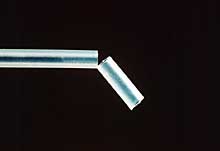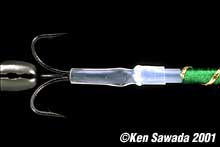- HOME
- KEN SAWADA COLUMN
- TACTICS
- Free Hook Method
KEN SAWADA'S FLY FISHING TACTICS
Free Hook Method
How to Set the Free Hook

1 Cut out the edge of the plastic tube straight.

2 Cut out 3-5 mm of it to fit the hook size. This forms a short cover tube. Be careful to make the cross section vertical and smooth.

3 When you tie your fly body around the tube, tie it so as to cover almost completely the rear end of the tube.

4 When you set your hook, put the leader also through the short cover tube, put the leader to the hook.

And insert the hook eye into the short cover tube.

5 The fly and the hook drift as one body due to the water pressure. But the moment the fish bites the fly, it separates from the hook.

6 The short cover tube keeps the balance of the hook in the water.

Set a short cover tube on each of several hooks in advance so that you can change your hook quickly. Don't forget to choose the tube fit for the hook size.

My New Flies set with ST2 as a free hook
Pheasant Squilla (above) and Jungle Squilla (below).
Pheasant Squilla (above) and Jungle Squilla (below).
Setting a hook to the tube fly body
What is the difficulty in dealing with the tube fly body? I am sure almost all of its enthusiasts mention its hook setting method. We will never like to set the broken or undone silicone rubber tube back to the tube body, no matter how many times we may practise. Therefore, some of us complete the setting by inserting the hook directly into the rear end of the plastic tube. But this method has got several problems as I try to explain from now on. In addition, this method is not suitable for aluminum or copper tube.Now a new method has been invented, which can solve these troublesome problems and get over disadvantages instantly. It is said that a certain Swedish angler devised it five years ago. A Swedish guide, Jonas Hommarstedt taught it to me and I tried it last year (in 2000). It did a splendid achievement. I really thankful the angler for his discovery with the simplicity of Columbus's egg.

Jonas Hammerstdt
Photo by S. Hirano
Photo by S. Hirano
Before I examine what excellent idea it has, let me point out the troubles in the past.
Tube Fly and Treble Hook
It is about 50 years since the tube fly was used for the first time. The prototype was a simple one just to tie the tail hair of stout around the plastic tube, but it did a really good job. At that time a small treble hook was directly inserted in the rear part of the bare tube. That method was not troublesome at all but utterly epoch making because the first tube fly was the small-sized one for the low water. Even when the fish bites it slightly, the small fly fits into the mouth deeply and its short tube does not hinder the hook working so much.As the tube fly became popular, however, various sizes and materials were introduced, which caused some problems.
Large-sized Tube Fly


A New Free Hook Method
The hook and the fly work as one body until the fish bites the fly and at the next stage the hook works separately and freely. That has been anglers' dream for a long time. Now I think I can safely say that our dream can be nearly realized by the new idea that I introduce here.
I tried the new method this summer for the first time and caught two salmon, which took my hook in an unusual way. The hook got stuck in its nose of the one and from the outside of its lower jaw of the other. I have never hooked salmon in those parts before. It is hard to think that salmon took my hook in this way for the first time in my fishing life. Probably not a few salmon must have taken my hook in this way before. But my hook came off quite easily and I could not notice my hooking, so I think. The most typical case was a strong fighter of 12.5kg that I caught in July. I used the hook ST2 No.8 to pull this strong salmon out of water. Usually the hook might have gone flat or come off after tearing the inside of salmon mouth. I realized once more how well the bare hook followed the fish moving.
As for casting troubles I had only twice a day on the average, a negligible figure I think, although I cast almost all day long.
Translated into English by Miyoko Ohtake.
- TROPHY CLUB
- FLY SHOW
- EXHIBITION
- MASTERS`
- FLY DRESSING CONTEST Archives
- TRAVELLER Archives
- TACKLE IMPRESSIONS Archives
- ANGLERS` PHOTO GALLERY Archives
- ----------------------------------------------
- トロフィークラブ
- フライショー
- エキシビション
- マスターズ
- フライドレッシング・コンテスト・アーカイヴ
- トラヴェラー・アーカイヴ
- タックル・インプレッション・アーカイヴ
- アングラーズ・フォトギャラリー・アーカイヴ
株式会社サワダ 185-0021 東京都国分寺市南町3-13-4
SAWADA'S INC. 3-13-4 Minamicho, Kokubunji, Tokyo 185-0021, Japan
写真・ドキュメントの無断転載を禁じます。
All the images and documents found on this site are owned by Ken Sawada and may not be used without permission.
But, link to this site is FREE.
Copyright © 2000 - 2025 SAWADA'S INC.. All rights reserved.
SAWADA'S INC. 3-13-4 Minamicho, Kokubunji, Tokyo 185-0021, Japan
写真・ドキュメントの無断転載を禁じます。
All the images and documents found on this site are owned by Ken Sawada and may not be used without permission.
But, link to this site is FREE.
Copyright © 2000 - 2025 SAWADA'S INC.. All rights reserved.